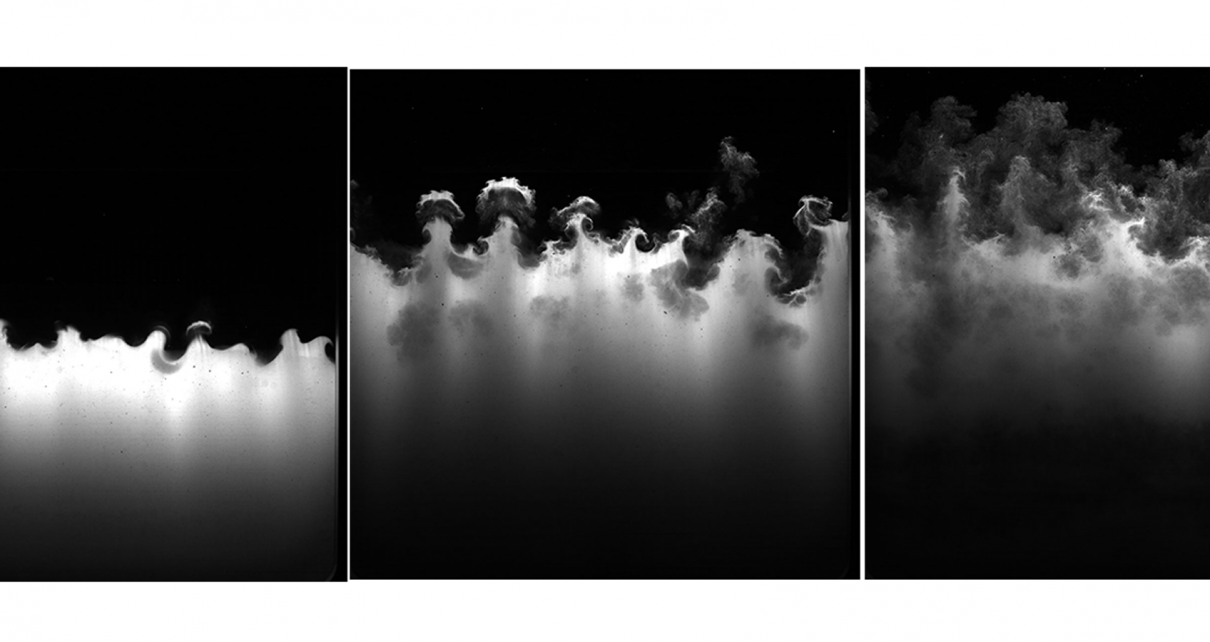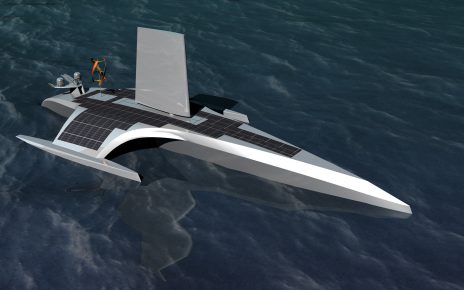When a star explodes at the end of its lifetime, it smears the elements forged in its heart across vast stretches of space. The results, dramatic designs of gas and dust known as supernova remnants, contain structures that have long puzzled researchers. But supernovae occur in the Milky Way only once or twice a century, often without warning, making it difficult to study their initial moments. Researchers have modeled these events through simulations, but computing limitations require them to make assumptions about the finer details.
Researchers at the Georgia Institute of Technology hope to change that with a new experiment to look at how gases in a supernova might mix, confirming and helping to refine previous simulations. Their wedge-shaped apparatus—which they sometimes call “supernova pizza”—is about four feet wide at the top and roughly the thickness of a double door, enclosing two separated, inert gases. Its shape lets it re-create physical dynamics as they would occur within a slice of a cylinder or sphere in space. The team sets off commercial detonators at the point of the wedge, which mimics the center of a supernova, and the blast waves mix the two gases. A high-speed camera snaps images of the process every 0.1 millisecond, revealing the equivalent of roughly the first hour after a supernova explosion. The researchers described the experiment in June in the Astrophysical Journal.
The team observed how small perturbations along the line where the two gases meet are amplified by the push-and-pull nature of the blast waves, forming mushroom-shaped disturbances that quickly grow larger. These curls of gas create turbulence, eventually forming low-density bubbles and long, high-density spikes. If a spike travels fast enough, it can break off and accelerate like a bullet to pierce several layers of gas.
Researchers have puzzled over outflows of heavy elements that come from deep within supernova explosions and behave similarly to those spikes. “It isn’t clear if we’re seeing something due to the intrinsic, asymmetric nature of the explosion or if it’s actually due to the turbulence happening,” says Anthony Piro, a supernova theorist at Carnegie Observatories in Pasadena, Calif., who was not involved in the research. The new study illustrates how strong an effect turbulence might have, Piro says, although further checks are necessary to understand the model’s limitations.
Most supernova models incorporate basic assumptions about what happens at the smaller scales to avoid weeks of extra computational time, Piro says. The new research helps to evaluate such assumptions. Scientists now “can see different, smaller-scale structures evolve,” says Carolyn Kuranz, a physicist at University of Michigan, who was also not involved in the work. The structures created by the experiment resemble what she has seen while investigating how plasmas mix: “Theory predicted that they should be similar, and [the researchers] found them to be.”
According to Piro, the experiment provides “an amazing confirmation of a lot of the physics” involved in supernovae. He says it will help calibrate the models he works with while giving scientists a better understanding of supernova and remnant observations.
Building a supernova-in-a-box came with its own challenges. Earth’s gravity is much weaker than a dying star’s, and tiny commercial blasters produce far less energy. But “even though the explosive pop is smaller, the other things we are dealing with are also smaller, so the ratios match,” says Benjamin Musci, a Georgia Tech graduate student and the study’s lead author.
Preventing gases from bouncing off the experiment’s sidewalls, which obviously do not exist in space, “was a long and arduous battle,” Musci says. It took him nearly a year to figure out a surprisingly simple solution: lining the walls with packing foam from a new computer’s box. The material absorbs the gases, stopping them from reflecting. “This foam gets blown to bits every so often by the explosive, so it slows down our run time,” he adds. “But without it the physics would be completely different.”
Another concern is dimensionality. Piro notes that gases expanding in two dimensions tend to act differently than they would in three, creating larger eddies and taking longer to break apart. This is something the researchers may work on in the future.
Previous supernova experiments have been performed at larger scales, says the study’s principal investigator, Georgia Tech astrophysicist Devesh Ranjan. Sites such as Lawrence Livermore National Laboratory train dozens of lasers on material the size of a pencil eraser, evaporating it to trigger an impressive blast. The trade-off comes in the amount of detail, Ranjan says: the bigger experiments generate few images, with only fleeting glimpses of the structures produced. But the supernova pizza manages 200 shots in a few seconds as the gases mix. “What our experiment provides is a dynamic view of the whole process,” Ranjan says. By combining insights from both kinds of experiments, “we should be able to say something jointly about what’s going on in a real-life supernova.”
Piro is not surprised that the team’s experiment is the first of its kind. “You have to be an expert in all different types of experimental techniques to put this all together,” he says. “The creativity of this group in trying to address these problems in a laboratory setting is really inspiring to see.”
Combining this study with others that probe different aspects of supernovae, along with evolving models, will help researchers eventually tease out details they cannot observe when a real star explodes. “If a universal model that describes what is occurring on different scales is the overall goal,” Kuranz says, “using these experiments—especially at different scales and under different conditions—can help push toward that.”



